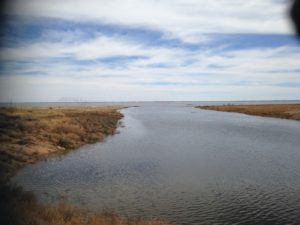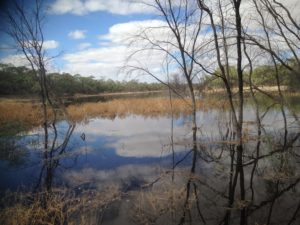Basin Plan – My perspective on where this is taking our region.

Cawndilla Lake (Menindee) Nov 2016
There is no doubt that the “Basin Plan” was a major direction change and a big deal for not just all the residents of the basin, the whole country. I think it was ground breaking for this to come about, my concern isn’t that the plan was initiated, I’m really concerned that nobody is willing to adapt when there are significant unintended consequences that are extremely detrimental. Only a fool would think that they could implement a plan, getting all aspects right from day one and taking all consequences into account. Really smart people, like say “Apple” know that regularly there needs to be updates and adaptions, so unintended consequences don’t crop up and negatively impact on the whole project.
My understanding of the original basic intent of this Basin Plan was to:
- Address the over allocation of the river
- Restore environmental health
- Directing water to high value crops

Anabranch River eflow 2017
How are we going towards achieving these?
-
Address the over allocation of the river:
My understanding of the intent was to purchase water from willing sellers to reduce productive use and increase water for the environment. Water has been purchased from willing sellers and then that water has been re allocated to the environment. The major target that is spoken the most about when discussing this plan is the number, the actual amount of water taken out of production and reallocated to the environment, this has by default become the overall target.
As my language in the above section explains, water that has been purchased from production and then reallocated to the environment, doesn’t help the over allocation of river water, the river is still over committed. Add to this the ”water efficiency” projects, where changing of infrastructure that doesn’t “lose” (read evaporate, transpire or infiltrate) as much water, where those “savings” have been turned into allocations and transferred to the environment, again all around this magical number.
If the Basin Plan was looking at addressing the over allocation, a simple way would’ve been to purchase water licences and then promptly terminate them, let the water flow down the river.
-
Restore environmental health
I don’t have any evidence that the environment is or isn’t improving, my perspective is from the Lower Darling and there is no allocation for environmental water in this area. From what I see the water is predominately used to water gum trees at selected sites along the Murray River and there has been some fish breeding at those sites. This is however meant to be a basin wide plan, so why should there be focus on a few selected areas? Why too are the River Red Gum and Murray Cod held up as iconic species? We have far too many gum trees along the river and the cod fish is going OK eating the carp, if we are serious about improving river health, focus should be on species such as silver perch, phragmites, or native willow and Murray Crays.
-
Directing water to high value crops
The thinking on paper makes sense, to make sure that the water is valued and used where it is bringing the biggest return to the economy. The outcome of this attitude has been to shift water to a few perennial crops (currently table grapes and almonds) at the expense of a diversity of crops that use water at different times of the year and annual plants that don’t consistently need water. This has resulted in water being used further away from the source, as more land that is suitable for these crops is mainly in the last half of the Murray, this then impacts on river flows required from upstream dams. In the southern basin this has seen high river flows past the upstream section of the Murray for most of the summer, yet those regions unable to use any of the water, the temporary trade price is too high.
In the northern basin where there are many less dams, due to significant quantities of water being bought back and the water market isn’t as active, there is more pressure on higher security (A class water). Large reductions in water being used to grow crops has meant significant loss of economic activity through those river towns, with every megalitre used having an economic flow on effect (Fertiliser, agronomist, herbicide, seed etc), there has been big social impacts in those towns. These irrigators predominately grow cotton due to customer demand meaning that it gives them the highest rate of return for their water. Cotton is really suited to the northern basin; the balance needs to be made between irrigation water and making sure that fresh water is allowed to flow to the Murray as often as possible.
What I reckon needs to change:
- Water bought from willing sellers needs to be unallocated, thereby increasing the security of water users and reducing the pressure on the river. Environmental water is still an allocation and adds pressure to the river and the communities along the river. I would recommend around 50% of all water purchased be unallocated, having a significant increase in security of then all the other water users that remain.
- All communities need to have a role to play in improving the river health and they all need to directly benefit from it. By this I mean that each community needs to have ownership of environmental water and have rules to operate under and targets to meet, they can then utilise that in their own unique way. We also need to especially include indigenous knowledge into our river management, the tribal groups along the river have much to teach us about river management, if only we choose to listen and acknowledge.
- I would look to encourage diversity of crops along the river, especially in the south. Some tools for this might be:
- To have different months (eg. August water) for different water entitlements, encouraging people to use water more evenly through the year.
- Accurately allow for transmission losses when water trading, not just either side of “the Choke”, a megalitre of water at Moulamein is very different from one at Renmark.
- Make sure that there is a clear percentage of water that can be used for permanent planting, with a much higher percentage of water being used for annuals, maybe water licences could be tagged for the crop they can grow.
- The basin plan should be primarily about improving river health, it shouldn’t be about securing the value of water or encouraging investors into the market. Communities benefit from water being used in their own community.
- There needs to be regular changes to water entitlements/security (reviewed twice per year) so that the agreed targets are hit and this plan is kept on a clear agreed course. The health of the river and communities along it depend on this plan being a success.
- The success or otherwise of the water efficiency projects needs to be reviewed, taking into consideration the loss of water seepage and evaporation.
- The current target, being a number with no bearing on environmental improvement needs to be erased and clear SMART targets around genuine environmental improvements need to be set. Targets need to be developed for all reaches of the basin, not just so called “icon sites”, a poor culture that needs changing.
Wrap up:
I have tossed my ideas down here as I have been to many so called “Basin Plan” meetings and all that happens is defence of the current situation. All the defence is telling me is that “the MDBA and state water agencies all know that the current situation is no good, they have no idea how to change it, so don’t want anyone else to know that it is a mess.” This is the unwritten rule of defence and certainly an area that Govt departments usually fall for. This plan is really detrimental to most of the basin and is placing farmers against farmers in fights for water, due to inaction from water agencies, this is not OK.
As always this is only my perspective and I welcome input and corrections from others that feel strongly about this issue.

Darling River at Wentworth
